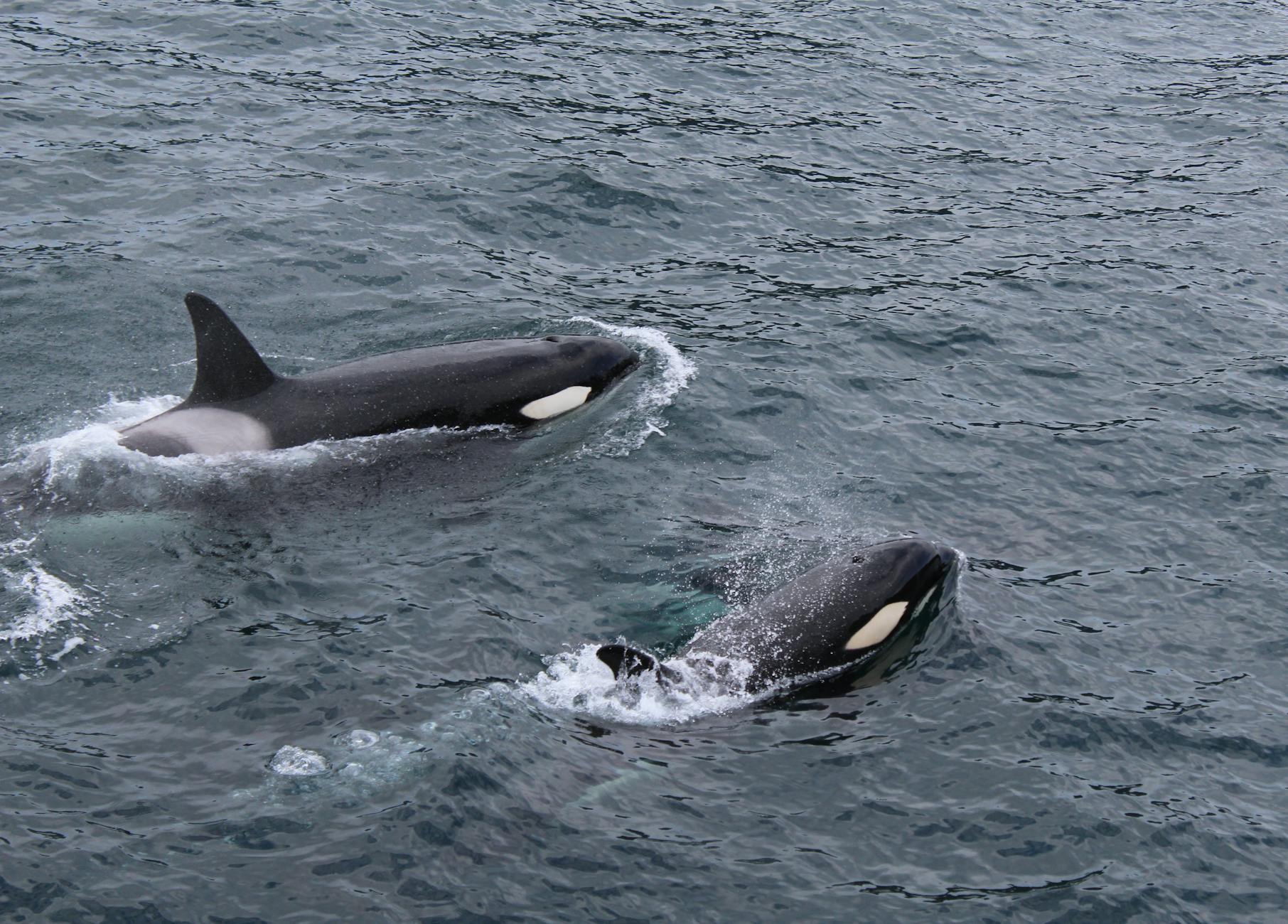Great Whales! They are the largest mammals on Earth even larger than the largest dinosaur. Whales live their entire lives in water. Their weight would crush them without the water to support their bodies. They have a fishlike shape, but their tail fins called flukes are horizontal rather than vertical.
As they have paddle like front limbs, called flippers. Their skin is smooth and glossy and, depending on the species, may be black, white, gray, and bluish. Some are marked with a variety of colors, from cream to yellow.
Beneath the skin is a thick layer of fat, called blubber, which serves as a source of stored energy and insulation.
Despite their enormous size, they feed on some of the smallest organisms in the sea. Favored foods include copepods and euphausiids (also called krill), or schools of small fish. Whales are found in all oceans of the world.
They are widely distributed, and a single species may be broken into several different stocks. A stock is a group of whales that are geographically isolated from other members of their species.
For example, the Alaskan stock of humpback whales travel to Hawaii for the winter months and they do not mix with the Antarctic stock of humpbacks that migrate to Tonga for winter and calving.
Whale Facts
Each whale species has distinctive characteristics and behavior patterns. The great whales are always of interest to students. Great whales are those of great size, including the gray, humpback, right, blue, sperm, bowhead, fin, sei, Minke, pygmy right, and Bryde’s whales. Within this group, the size varies greatly from species to species.

Classification of whales
Whales are mammals and share certain features with mammals, such as being warmblooded and giving birth to live young. Because whales are aquatic mammals, they are classified in the specific order of Cetacea, making them a cetacean. Suborders are used to make the major division between toothed whales (odonticeti) and baleen whales (mysticeti).
Odonticetes have jaws lined with pointed teeth that are used in hunting fish, squid, and other prey. Mysticetes (baleen whales) lack teeth.
These whales use giant, flexible combs of material called baleen to filter small fish and tiny crustaceans from the water. Work through the following activities to learn how whales are classified into various divisions.
Whale Habitats
To discover where whales live and what areas of the oceans are used for feeding or giving birth, we first must be able to find them. During the early whaling days, the word got out when whalers were successful. Since most of the whales had regular seasonal migrations or were plentiful at a certain place at a certain time, their locations were predictable.
As places where whales hung out were discovered, the whaling fleets followed. When whaling vessels met at sea, they shared the stories, successes, and failures of the voyage.
This was called “gamming.” Also, the accuracy of maps and charts was improving, and locations where whales had been seen could be easily passed along. As you have learned, the whales that were the easiest to find and the slowest were the ones the whaling fleets went after first.
But the whalers’ knowledge about the whales consisted only of where they could be found and how much whale oil they were likely to produce. That was all that was important to them to have a successful whaling voyage.
Today, we are trying to bring them back from near extinction. And that means we must know not only where the whales are found, but also where they are going, what hazards they encounter in today’s busy oceans, what they are eating and what is eating them, and where they mate and give birth.
We must know what kind of habitat they need to answer many of these questions. The early whalers knew little about habitat. After all, they could only guess what it was like under the surface of the ocean, and most of a whale’s life is spent under the surface. The whalers knew only a little piece of the lives of whales, and we need to know the entire life cycle if we are to help whales recover.
For instance, if we don’t know what they eat, we can’t protect that part of the ocean that produces their food source. Oceans have many different habitats, and, like land habitats, they must provide food, water, oxygen, shelter, and living space.
There are shallow water areas surrounding continents, habitats on continental slopes that drop to the ocean basin floor. Moreover, habitats on underwater mountain ranges and flat sandy plains.
There are even habitats in deep ocean canyons, called trenches, that are nearly seven miles deep. There are undersea mountains and volcanoes, rocky reefs and coral reefs. Each of these areas can be called a habitat.
Warm water zones, cold water areas, and areas where winds mix the waters in a process called upwelling, all contribute to the factors that make each habitat unique.
Whales depend on different habitats just as land animals are associated with different habitats. Destroy or damage the habitat and the whales will decline in numbers.
“Whale Fact Sheets,” most references gave broad areas of the oceans as the habitats for whales. But scientists who are interested in whale biology must locate the specific areas of the oceans where these whales live and learn what makes the area important to the whales. Land animals can’t survive when their habitats are destroyed.
The same is true of whales. Using radio tags, oceanographic instruments, and satellite technology, scientists are tracking whales to find their feeding areas, calving grounds, and migration patterns.
Once these areas are identified, scientists collect ocean data such as temperature, salinity, plankton abundance, and ocean bottom types (for example, mud sand, seamounts, etc.). We know that whales seek out habitats that are very productive, areas that produce abundant food. Various regions of oceans are known to be very productive.
These include cold polar waters, continental shelf areas that are shallower than areas of the open oceans, and areas of upwelling. Cold polar areas can be very productive because these areas have long summer days with sunlight needed for plant growth.
These same areas have winter storms that stir the waters, bringing deep water to the surface. This water carries nutrients that fertilize the phytoplankton, which in turn feeds the zooplankton. Cold water dissolves gases better than warm waters, and that also encourages plant growth.
Exploitation of Whales
Whales have been hunted for centuries for subsistence purposes by coastal aboriginal (native) people all over the world. Subsistence hunting means early human hunters used the whales for food, clothing, and housing materials.
Whales played such an important role in their lives that for many aboriginal peoples subsistence hunting was incorporated into their cultural traditions as well.
Historical evidence indicates that right whales and gray whales were hunted in the North Sea and the English Channel from at least the 9th century. Native people in many countries still hunt marine mammals for subsistence and cultural purposes today.
For example, U.S. law permits Native Americans in Alaska (the Inuits) to hunt a limited number of bowhead whales for aboriginal subsistence purposes. However, the impact of such limited hunting pressure on marine mammal populations has been localized and small in comparison to industrialized whaling.
The first significant attempt at regulating international whaling activities came in 1946 through the establishment of the International Whaling Commission (the IWC). The IWC attempted to balance conservation with the economics of whaling.
The mission of the IWC was “to provide for the proper conservation of whale stocks and thus make possible the orderly development of the whaling industry.” The IWC covers all commercial pelagic whaling activities of member nations.
However, the IWC is limited in its ability to inspect and enforce its own rules and regulations. Any nation can “object” to any decision it doesn’t agree with and excuse itself from the limitations of that decision.
Member nations can also issue their own permits to take whales for scientific purposes. Although the IWC was established as early as 1946, the reduction in whale populations continued.
Current Threats to Whales
There are few environmental issues that do not directly relate to human impacts on the planet. These impacts are harmful to the great whales. Most conservation issues for whales are now tied directly to human impact on ocean habitats, on which these great creatures depend. Human activities and the world’s oceans People, people!
They are everywhere, and every year 81 million more are added to the Earth’s population, according to 2001 statistics. The world’s population is predicted to grow from the present 6 billion to 10 billion before leveling off. There is no doubt that people impact the Earth.
Although the number of whales that are killed each year has been reduced, human activities bring threats. That have replaced whaling as the major concern for saving these unique animals.
Human population growth, both globally and in the U.S., adds more toxic chemical pollutants to the water, intensifies the need to explore for more oil and gas. That’s increases the number of ships on the seas for shipping products from country to country.
More people create more demand for fish. Adding more humans to the planet also releases more carbon dioxide into the air, which in turn traps heat and changes climates.
We may be protecting whales from hunting, but there are many other issues that concern agencies working to protect whales in the 21st century.
How Many Great Whales Are There?
Great whales are among the largest animals on Earth. Scientists recognize about 13 species as “great whales.” These whales belong to the baleen and toothed whale families. Species like the blue whale, humpback whale, and fin whale are considered great whales. These giants live in oceans worldwide, from polar regions to tropical waters.
Conservationists monitor their populations closely because many great whale species are endangered. Pollution, ship strikes, and fishing gear entanglement threaten these whales. Conservation groups like the International Whaling Commission work to protect them. The blue whale holds the title as the largest great whale species.
Other large species include the sperm whale and the bowhead whale. Each great whale species has unique characteristics and habitats. The decline in their populations concerns scientists and activists. Conservation efforts continue to help great whales thrive.



Pingback: False Killer Whale Facts, Size & Lifespan